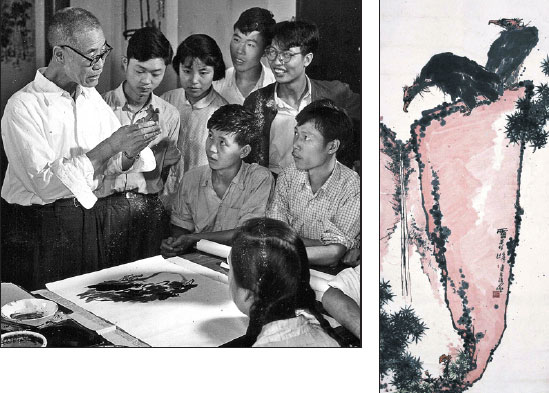Savior of a genre
The flower-and-bird painting style might have disappeared last century if not for Pan Tianshou, whose works are on display to honor his contributions. Lin Qi reports.
The traditional flower-and-bird painting genre may not have survived in the second half of the 20th century if not for Pan Tianshou (1897-1971).
He's recognizedas one of the four 20th-century masters of classic Chinese painting.
The luminary's works that blend scholarly elegance and aesthetic grandeur sell for tens of millions of yuan at auctions today.
Still, he led a low-profile and frugal life.
He committed himself to art education and taught at high schools and colleges. His students include such masters as acclaimed Chinese-French abstract painter Zao Wou-ki (1920-2013).
But his devotion to instruction meant he left behind only several hundred paintings - far fewer than other celebrated artists of his time.
Pan once said: "I have been a teacher all my life. Painting is my side job."
He headed the Hangzhou-based China Academy of Art for two tenures. His son, Pan Gongkai, now 70, later assumed the same position.
The academy is exhibiting 120 paintings out of his oeuvre at the National Art Museum of China in Beijing to mark the 120th anniversary of his birth.
The show, Ethos and Fortitude, commemorates his greatness as a man, educator and painter.
Pan Tianshou is known for his unyielding character. He dedicated himself to modernizing education about, and the creation of, Chinese ink-brush traditions at a time when the classic ink painting faced a decline in the chaos of early 20th century and Western painting was flourishing in the country.
The China Academy of Art's head Xu Jiang says Pan Tianshou's spirit demonstrated by two seals found on many of his works.
One is inscribed with "always be overwhelming" and the other with "stand upright".
"He meant that creators of Chinese culture should be confident, assertive and independent," Xu says.
"He said that Chinese and Western art were two peaks that stood apart yet could interact with each other."
The exhibition's works exemplify his endeavors to enhance a fearless, noble spirit of Chinese painting, which was waning after the Song Dynasty (960-1279).
Pan Tianshou revisited the motifs of rocks - which often take up more than one-third of his compositions - tenacious pine trees with twisted branches and ferocious eagles.
He softened the rigidness of these subjects by adding colorful clusters of wild grass on the ground and blossoming flowers on the treetops.
A fine specimen of this is Everlasting Glory, a 6-meter-long piece Pan Tianshou created in 1964 for the celebrations of the 15th anniversary of New China's founding.
It's his largest work and the centerpiece of the exhibition. It depicts three eagles standing on a huge rock and another one resting in a pine tree.
His distinctive approach saved the flower-and-bird genre as it was being abandoned by mainstream aesthetics in the 1950s. The genre was then criticized for embracing a scholarly style of self-enjoyment and lacking grand momentum. Some even said it would someday be replaced by oil painting.
Pan Tianshou reformed the genre to return it to the general public's attention.
In his book, History of Chinese Painting, he wrote: "There are people who, when they see novel things from a different culture, give up their own culture entirely and worship the new one.
"Art benefits and progresses every time different cultures interact. There has never been a situation in which one kind of art is destroyed by another."
China Academy of Art professor Fan Jingzhong says three kinds of people "live in the palace of fine art". The first "works to earn bread". The second seeks spiritual satisfaction. The third group - to which Fan believes Pan Tianshou belongs - is distinctive in that art is a socially ambitious expression of their views of culture during times of dramatic change.
Indeed, Pan Tianshou was an exceptional artist but an ordinary man when not using his brush.
Pan Gongkai says his father lived "as simply as a farmer".
"His favorite dishes were street food like baked beans and fried rice cakes. He swept the courtyard we lived in every morning. When he was the headmaster, he had a car and a driver, but he never used them. He felt uncomfortable in a car," he recalls.
"He didn't pretend to be frugal. He just thought it was unnecessary. He preferred walking and taking the bus."
Pan Gongkai says his father didn't talk much outside the classroom, and when he needed to, he spoke slowly and gently in a way unlike his apparent machismo.
"Although he suffered many setbacks and was often under huge pressure, he didn't complain at home. He didn't bicker with my mother. I often heard them talking about poetry," he says.
"He was sensitive to beauty and had a big heart. That's why he became a good artist."
Contact the writer at linqi@chinadaily.com.cn
If you go
9 am-5 pm, through Sunday. 1 Wusi Street, Dongcheng district, Beijing. 010-6400-1476.
|
The Beijing show Ethos and Fortitude is to celebrate the 120th birthday of Pan Tianshou, who devoted himself to the revival of Chinese ink painting in the 20th century. Jiang Dong / China Daily |
|
Above: Pan Tianshou instructs students of the ink painting department of the China Academy of Art in 1963. Right: Eagles are a major subject in Pan's works. Photos Provided To China Daily |
(China Daily 05/09/2017 page20)
























